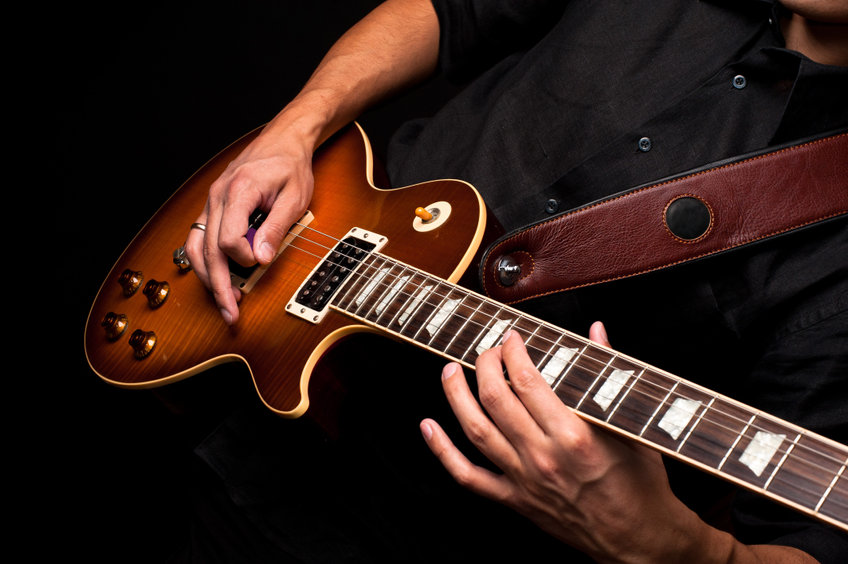Electric Guitar String Gauges Guide
Jun 28th 2023
Acoustic or electric? Each type of guitar has its pros and cons, but electric guitars do offer some intrinsic advantages. For example, they tend to be smaller and easier to handle than acoustics. Because you don't have to pluck their strings as hard to make your music, they can be easier on the fingers. And who knows? If you get really good with your axe, you may become the next Jimi Hendrix, Roy Buchanan or Eric Clapton. Even if you're just a rock star legend in your own mind, we all can dream, can't we?

But if you're going to play an electric guitar, you will need some strings for it. You will want the best-quality strings you can afford, of course, to coax the sweetest sounds possible from your instrument. It will also be important to get the right type of strings. That means not just getting the best brand and material but the right electric guitar string gauge. Keep reading this guide from Strings and Beyond to get a better idea of what electric string gauges are and why they matter.
Gauging the Gauge
What are electric guitar string gauges? We're glad you asked. As a purveyor of all things strings, Strings and Beyond is happy to offer this electric guitar strings gauge guide.
When it comes to what a string gauge is, it's really very simple: The term just refers to how thick or thin guitar strings are. When you look at packages or descriptions of electric guitar strings, you may see identifying descriptions like extra light, light, medium or heavy. Or you might see numbers well to the right of the decimal point, like .008, .024 or .046.
These tiny numbers aren't as complicated as they look. They simply refer to the diameter of the string in inches. So .008 would translate to eight thousandths of an inch, and .046 would mean 46 thousandths of an inch.
Usually you will get a mix of sizes in a pack of strings. A package labeled "light" will have strings in the thinner range. "Medium" will have sizes in the middle, and "heavy" will have strings that scale to the thicker sizes. Typically the thinnest string in the pack will tip you off whether the package is extra light, light, medium or heavy. Here's a tip on the nomenclature: A pack of light strings with the lightest string measuring .009 can be called a set of 9s, while a pack of medium strings with the thinnest string measuring .011 would be called a set of 11s.
Hybrid sets are also available. These combine a couple of sizes - for instance, medium and heavy. These can give guitarists a bit more flexibility and versatility in their playing.
String Theory
Why should you care about string size? After all, they will all make music, right? Actually, the string gauge will have an important effect on how your guitar feels, and how you play it. Lighter strings will feel a little easier on the fingers and be easier to bend. They will also produce a somewhat lighter, more trebly tone than heavier strings.

String gauge can affect your guitar as well as you and your music. Heavier strings will require more tension on your instrument, which can put pressure on your guitar's neck. Because of their lighter tension, lighter strings tend to have more side-to-side movement than heavier strings. To avoid fret buzz, guitars with lighter strings will need more space between the strings and frets. As the name implies, "fret buzz" means you will get a buzzing sound rather than clear notes if your guitar hasn't been properly adjusted for lighter strings.
Most players use electric guitar strings with 9s or 10s. These sizes are common on electric guitars sold, too. They are ideal strings for all-around playing. Beginners in particular would benefit from starting out with these sizes of string gauges.
For faster playing or lead guitar, some more experienced guitarists go with lighter strings. At the other end of the spectrum, heavier strings are sometimes preferred for rhythm guitar and a bigger sound. In addition, heavier strings tend to stand up better to hard picking and hard playing than lighter strings. As you would expect, due to their smaller dimensions, lighter strings are more prone to breakage.
The Right Setup
If you are thinking about making a radical change in string size, this could require changes to your guitar's setup, which can include adjustments to the instrument's neck and raising or lowering string height.
So what are the right gauge electric guitar strings for you? The simple fact is there is no hard and clearcut answer. Every guitar player has a different style, from mild to wild and from soft rock to hard rock. Guitar playing styles are as different as guitar players' faces and fingerprints.
The best way for you to decide which gauge guitar strings are the best for you is to try a variety. Experiment to learn what feels the best, sounds the best and lasts the longest. There are hundreds of options for electric guitar strings out there. Read all the reviews you can and talk with fellow guitarists - keeping in mind, however, that there is no accounting for taste and that strings that wow dozens of reviewers and musicians may turn out not be your thing at all.
Nothing can substitute for trying strings yourself and seeing how you feel about them and the effect they have on your music. Compared to purchasing a guitar, strings cost very little. Putting in the time and effort to find the right string gauge is an investment that will pay off in better playing and more comfort in the long run.

